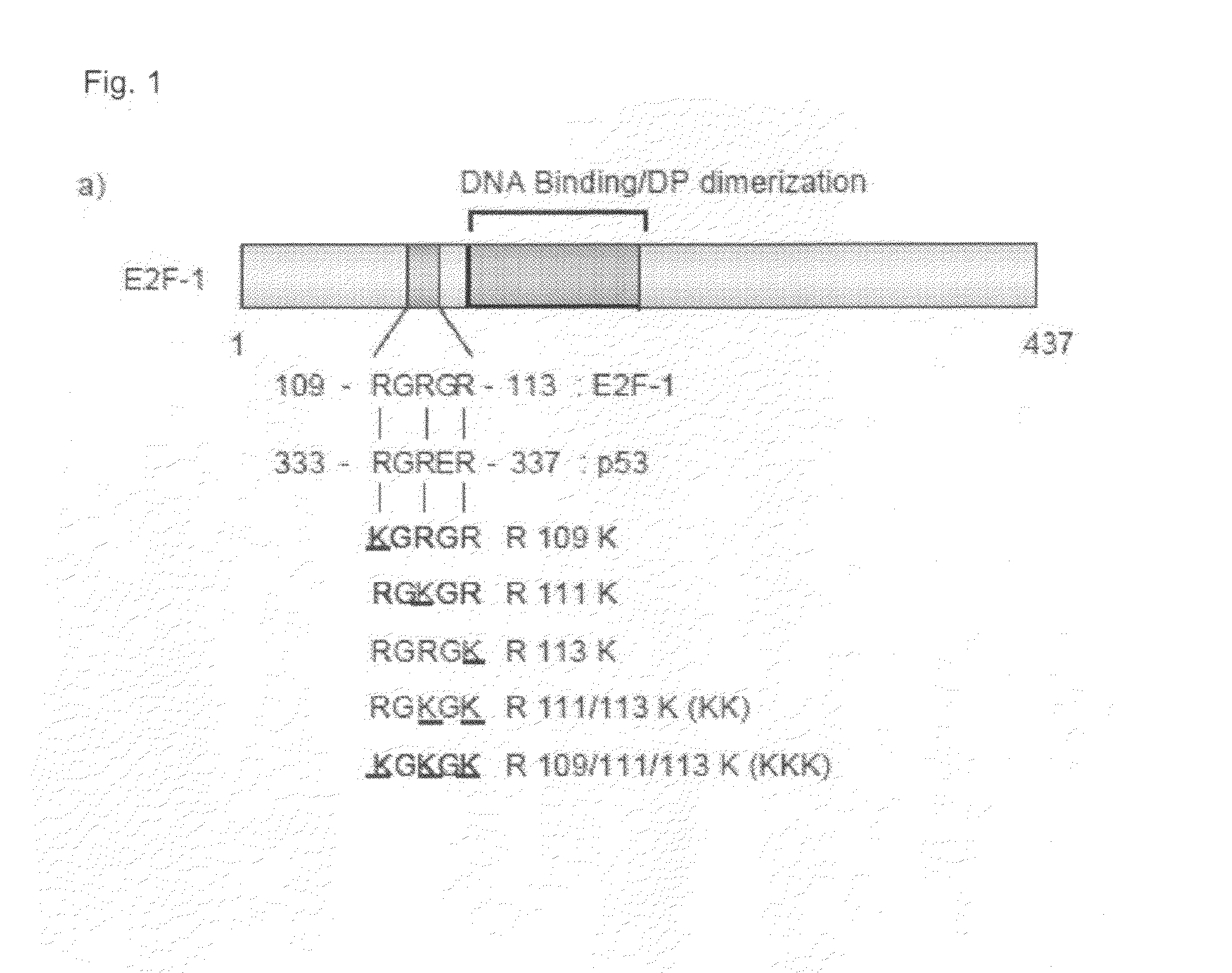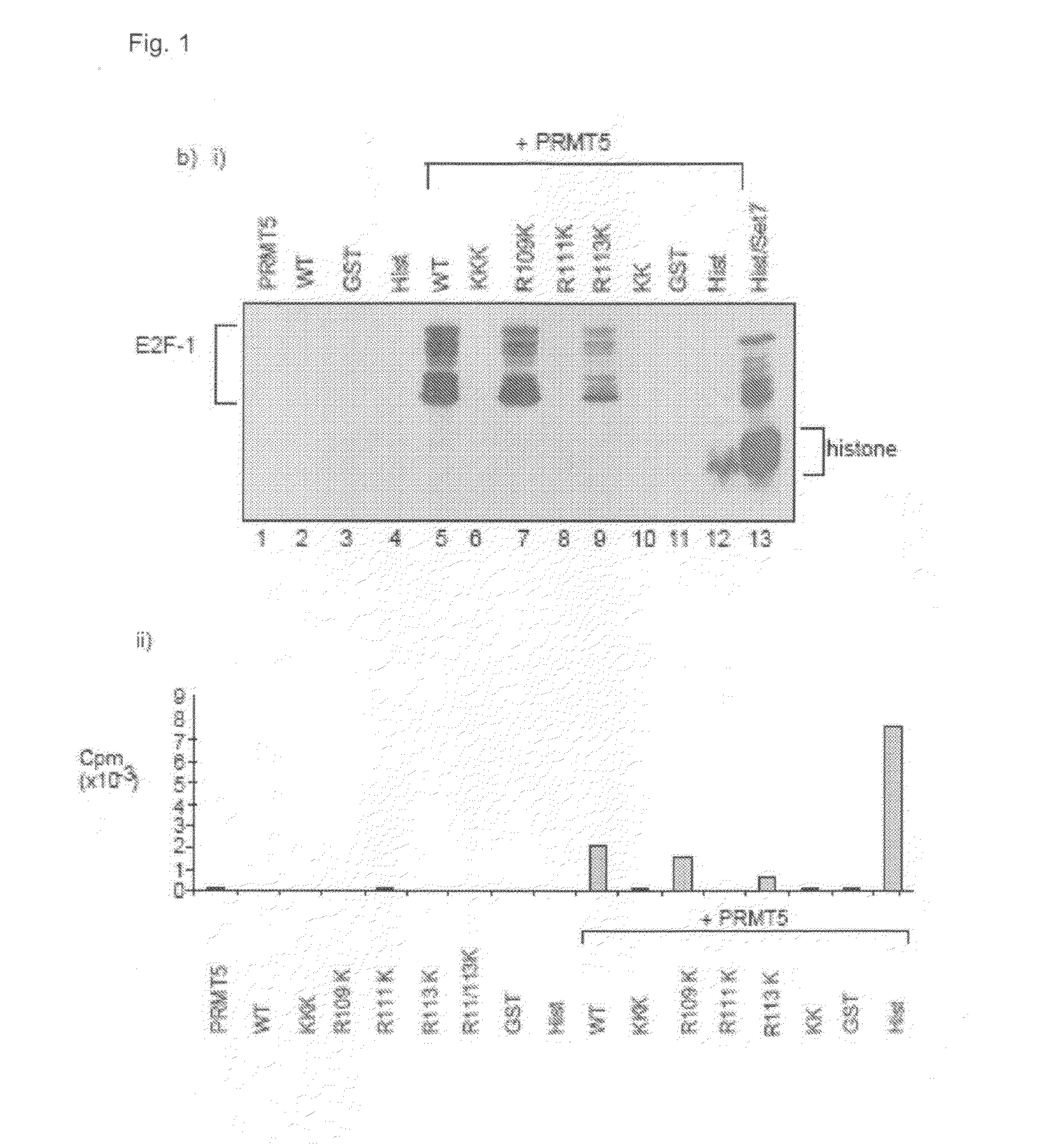Method of treatment and screening method
a screening method and proliferative disease technology, applied in the field of proliferative disease prevention and treatment, can solve the problems of elusive mechanisms that influence the diverse cellular outcomes ascribed to e2f-1 activity, particularly its apoptotic activity, and the cell context dependence of these events
- Summary
- Abstract
- Description
- Claims
- Application Information
AI Technical Summary
Benefits of technology
Problems solved by technology
Method used
Image
Examples
example 1
E2F-1 is methylated by PRMT5
[0091]A comparison with p53 identified a sequence motif in E2F-1, RGRGR, with similarity to the known sites of arginine methylation in p53, namely RGRER. FIG. 1A shows the location of E2F-1 RGRGR sequence motif in E2F-1, highlighting the similarity with the region in p53 targeted by PRMT5 (Jansson et al 2008). It is consistent with this observation that wild-type E2F-1 could be methylated in vitro by the arginine methyltransferase PRMT5.
[0092]To assess whether the RGRGR motif was a direct target for PRMT5 methylation, a series of mutant derivatives of E2F-1 were made in which each arginine (R) residue was substituted with a lysine residue (K; FIG. 1a), and the ability of the mutant derivative to be methylated in vitro then assessed. FIG. 1b shows the in vitro methylation of E2F-1 and the various mutant derivitives. In FIG. 1b(i) each of the indicated proteins (about 1 μg) was used in the methylation reaction. In vitro methylated samples were analysed by S...
example 2
E2F-1 is Methylated in Cells
[0097]It was investigated whether E2F-1 is methylated in cells using a site-specific methylated-arginine peptide antibody, prepared against a methylated RGRGR peptide taken from E2F-1, in which the predominant sites of methylation, R111 and R113, were symmetrically methylated. As shown in FIG. 2a, anti-MeR-E2F-1 recognised ectopic wild-type E2F-1 immunoprecipitated from cells, but failed to react with either the KK or KKK mutants, indicating that the antibody recognised the relevant region in E2F-1. Either wild-type E2F-1, KK or KKK expression vectors were transfected to HeLa cells and immunoprecipitated (IP) with HA11, followed by immunoblotting (IB) with anti-MeR E2F-1, HA11 (E2F-1) or DP-1 antibodies. The level of input (In) protein is indicated.
[0098]The specificity of the antibody for arginine methylated E2F-1 was established by immunoprecipitating ectopic E2F-1, followed by immunoblotting with anti-MeR-E2F-1 in the presence of competing matched E2F-...
example 3
The Effect of E2F-1 Methylation
[0103]Since arginine methylation of E2F-1 is regulated by DNA damage, and because E2F-1 is induced upon DNA damage (Stevens and La Thangue 2003; Iaquinta and Lees 2007; Polager and Ginsberg 2008), it was considered that arginine methylation may play a role in the controlling E2F-1 stability. When the level of ectopic protein was compared, both the KK and KKK mutants were expressed at increased levels compared to wild-type E2F-1. FIG. 3a shows the levels of wild-type E2F-1, KK and KKK after transfection (1 μg) into U2OS cells. ‘-’ in the left lane indicates untransfected cells. In part, this difference reflected their altered protein stability, because each of the KK and KKK mutants exhibited an increased half-life compared to wild-type E2F-1. FIG. 3b shows the stability of wild-type E2F-1, KK and KKK mutants. Expression vectors (1 μg) encoding wild-type E2F-1 (WT), KK and KKK mutants were transfected into U2OS cells for 48 h. Cells were treated with 10...
PUM
| Property | Measurement | Unit |
|---|---|---|
| Concentration | aaaaa | aaaaa |
| Catalytic activity | aaaaa | aaaaa |
| Biological properties | aaaaa | aaaaa |
Abstract
Description
Claims
Application Information
 Login to View More
Login to View More - R&D
- Intellectual Property
- Life Sciences
- Materials
- Tech Scout
- Unparalleled Data Quality
- Higher Quality Content
- 60% Fewer Hallucinations
Browse by: Latest US Patents, China's latest patents, Technical Efficacy Thesaurus, Application Domain, Technology Topic, Popular Technical Reports.
© 2025 PatSnap. All rights reserved.Legal|Privacy policy|Modern Slavery Act Transparency Statement|Sitemap|About US| Contact US: help@patsnap.com



